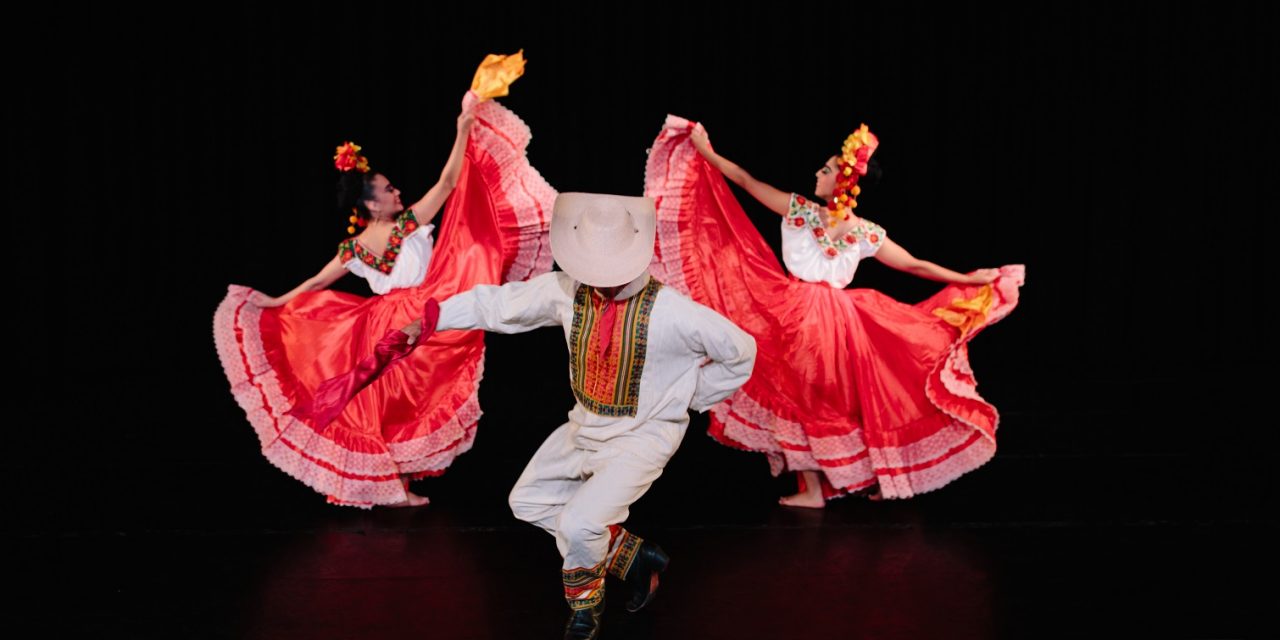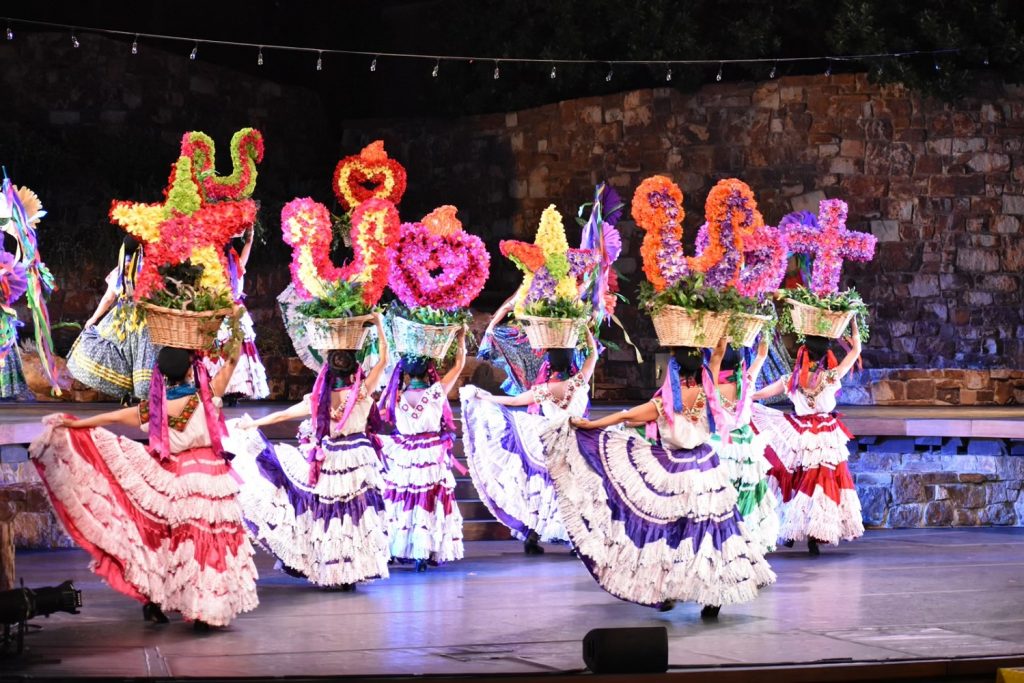On Saturday night, October 15th, glimmering with colorful lights, The Ford Theatre presented, Desde México, (from Mexico), the Pacifico Dance Company’s 30th Anniversary Celebration. A Los Angeles based company dedicated to the preservation, exploration, and education of Mexican culture. Under the helm of Artistic Director and founder Adriana Astorga-Gainey the jubilee incorporated premier dances from across Mexico. The event transported the viewer to these towns and this professional organization gave the viewer high-caliber folkloric scenes, costumes, and movement. All dance, including Mexican Folklórico, is passed down from generation to generation. Pacifico incorporates many forms of foundational work including ballet, yoga, modern and contemporary dance, to bring out the best in their performances. In the show it is apparent that influences from other cultures such as Spain, Afro-Caribbean, Eastern Europe and more have melded in through the years. It is also clear that the company improves upon dances of origin yet maintains their essence and foundational source of reference. An event for all ages, the Pacifico Dance Company demonstrates that the historical past and present can continue to contribute into the future.
Oaxaca
The opening paid tribute to Mexico’s southwestern territory, a state called Oaxaca and their tradition of the La Guelaguetza festival. It was spectacular and grand as the women came on stage with large baskets on their heads and inside an extra-large colorful pinata, laid in greenery and signature long braids. This choreographed scene by Adriana Astorga-Gainey called Orgullo Oaxaqueño, was delightful and embodied the vibrant colors that the Mexican culture is iconically known for. The dance of origin is a dedication to the patron saints of the area. Ms. Astorga-Gainey kept a solid grasp on the customs of this Folklórico parade as the Chinas Oaxaqueñas (native women of the territory) swirled in and out on a bi-leveled stage. The Pacifico Dance Company professionally moved more smoothly, lighter and with an on the beat bounce that is an astounding upgrade of los pasos (the steps) from non-professional dancers.
There were an-array of segments throughout the evening that pertained to different communities of Mexico. The men, in huge domed headdresses, were highlighted in La Danza de la Pluma (Dance of the feather). A ritual presented in many areas of Mexico that represents a battle between the Spanish and the Aztecs. This custom is a tradition of the state of Oaxaca, which Matthew de León and Adriana Astorga-Gainey purposefully sequenced the men in many circles and incorporated swooping dips which created a strong and serious nature. A difficult arrangement of ballet steps, sautés and saut de basques, including skips, leaps and turns, all while shaking maracas in time, this segment was an exceptional endeavored feat. The leading man in red, Uriel Ramirez, was a standout of the evening. His timing and musicality beamed from the stage and was always accurate in every number.
Chiapas
Next, choreography from Adriana Astorga-Gainey, is originally from the town of El Pijiji. An homage to the state of Chiapas, it is a lovely light visual of native movement danced barefoot – a cute segment of ladies with clothing baskets and an admirer. According to the organization the emphasis is on courtship in order of love, marriage and reproduction which are revered to their land. A Valz (Waltz), from the state of Chiapas, by Ms. Astorga-Gainey, filled the stage with multi- colored dresses, red heels, twirling in circles with many ballet balancés. The crowd felt comfortable as you heard gritones (vocal encouragement from the crowd) and algunos chillones (some Mexican shrills) of how beautiful the ladies looked.
Tamaulipas
These honoring routines of the state of Tamaulipas area were choreographed by Ms. Astorga- Gainey and Mathew de Leon. A celebrational dance called Picota from the centralized region, the women carried garlands in their hair and were in traditional looking red and white dresses. A number celebrating the end of a sugar harvest, the dancing included ground hops, female dosidos, and skips in bare relaxed feet. It was a joyous piece where the dancers appeared happy and relaxed. El Tamaulipeco, a first duet piece – then all cast, brought in an uplifting consistently strong dancer Monica Hernández and a lasso skilled enthusiastic Matthew de Leon. The two were delightful and on the music. The footwork in general was simple but included more hopping then most traditional Tamaulipeco pasos (steps), it worked well with the traditional music.
Guerrero
Ms. Adriana Astorga-Gainey conceptualized dances that symbolized the tropical climate of sweltering Guerrero. These lands are known for the beach front city of Acapulco; however, it also has an array of indigenous tribes including an original Aztec region, mountains, and volcanos. The program identifies their framework as the embodiment of the terrain’s climate. To quote their program notes, “reminiscent of the tierra caliente, or hot earth.”
El Palomo (The Pigeon) was very picturesque and showcased a trio Jessica Escobedo, Uriel Ramirez, and Samantha Zendejas, these three were smooth and a pleasure to watch. There were a couple pieces after this: La Mariquita (The Ladybug) and El Diablo (The Devil). In general, it would be nice to see more localized head movement, accents and synchronization, and there were moments when the groups not together. The men in La Mariquita swirled red scarves in the air and stomped on the stage. This was a valent section with heart felt music.
Veracruz
A sector in the coastal and southern area of Mexico, produces a mixture of Spanish flamenco and Afro-Caribbean beats. Originally choreographed by Daniel Rodriguez, La Bruja (The Witch) has been restaged by the Pacifico Dance Company. A fluid duet Natalie Bojorquez and Esmeralda G Magaña-Montion showcased old with the new by displaying flamenco type movement with a contemporary counterpart. In the mist, Esmeralda was mystifying and graceful in the flamenco section, while Natalie’s actions were smooth and effortless in her contemporary releases. In another adoration to Veracruz, La Bamba by choreographers Matthew de León and Adriana Astorga-Gainey, there is a display with a proud lovely lead couple Jessica Escobedo & Matthew de León as they easily tie a ribbon with their feet. La Bamba is a historical wedding dance, in which, in the 1950’s Richie Valens took in as inspiration for his rock version song, “La Bamba.” The Pacifico Dance Company’s stage show flaunted large stunning skirts, men in burgundy guayaberas, and plenty of foot tapping.
A lo Norteño
To celebrate the cultures of northern Mexico, choreographer Matthew de León presented a World Premier of A lo Norteño (To the Northerner). In a Polka style and high kicks this showdown strutted a fun elated time that reminded the viewer of Mexican Vaqueros (Cowboys). Lead couple’s Monica Hernandez in a blue skirt and in cowboy hat, Uriel Ramirez plus Samantha Zendejas in black pants, and in cowboy hat, Matthew de Leon did a fun job at acting out their scenes, while carrying on seamlessly through their high-spirited sections. Mr. de León’s talented work was of high caliber that really illustrated the dancers’ premier abilities.
Jalisco
In a potpourri Mexicano from the state of Jalisco, Mexican cowboy superhero Floreador Francisco Andrade, with his spinning lasso skills, were all-encompassing. He offered many looped rope techniques and tricks of the trade. His florescent rope had a large opening that took up most of the space on the stage. His flawless move of the “Texas Skip” was impressive and done with ease. An originating tool of Mexican Vaqueros (cowboys), Mr. Andrade was a wonderful addition to the event. At the end of his section, a willful and playful Monica Hernandez glided into the lasso with simplicity.
Another World Premier, dancer Uriel Ramirez composed an original composition called Son de Guerra (The beat of War). It is choreographed by Mr. Ramirez and Ms. A. Gainey in respect to Que Viva Mexico. Heart felt were the Viva Mexico belts from the audience members. The night would not be complete without men in mariachi outfits, La Culebra (The Snake) and El Gusto (The Taste), from the state of Jalisco, involved broader zapateado (footwork) from the men, marking the rhythm and syncopations. Manuel Soriano and Juan Guzman were standouts, with a nice display of head movements and personality. At the finale, the whole cast came out on stage and performed with a lively, high energy level that was impressive after this full complete program.
The Pacifico Dance Company is a Los Angeles gem and it was such a treat to see authentic Mexican dances all in one night. Adriana Astorga-Gainey has done an excellent job at cultivating the company’s professionalism as well as having a keen eye for superb artists and outstanding costume design. Southern California has a strong influence of Latino culture and heritage. Mexican heritage fills the air with yummy food, drinks, music and vida (life). Every seat is a great seat at The Ford Theatre, it is a perfect venue for watching large scale performances.
Dancers of the Pacifico Dance Company: Christian Cruz, Matthew de León, Carlos Escamilla, Jessica Escobedo, Jesenia Gardea, Victoria Gómez-Alvarez, Juan Valentín Guzmán, Alina Isabel Hernández, Clarissa Hernandez, Monica Hernandez Leyva, Ivan Lopez, Anthony Tosa Lopez, Candelario Montion, Esmeralda G Magaña-Montion, Adrian F. Maldonado, Camila Mier, Jorge Montes, Zarene Marie Núñez, Ciani Núñez-Murillo, Leslie Ortega, Andrea Osuna, Uriel Ramirez, Manuel Soriano, Christy Tablas, Kailey Tapia, Viridiana Velasquez, Noe Villagrana, Isabella Luna Zeller, and Samantha Zendejas.
To learn more about Pacifico Dance Company, please visit their website.
To see the full performance season at The Ford, please visit their website.
Written by Alice Alyse for LA Dance Chronicle.
Featured image: Pacifico Dance Company – Guerrero – Photo courtesy of the company.














